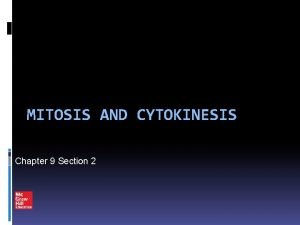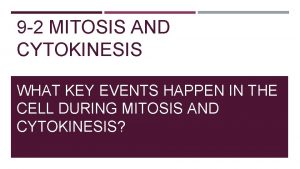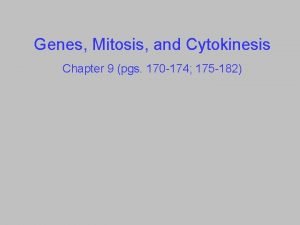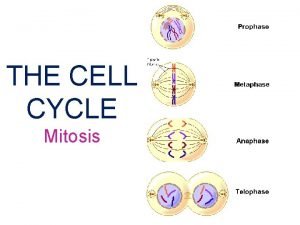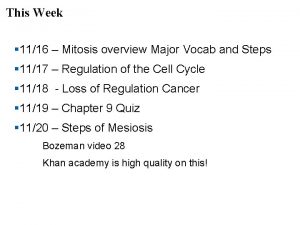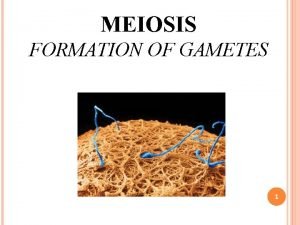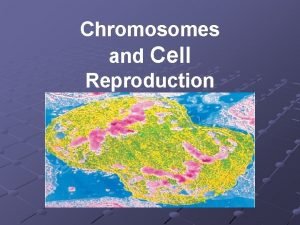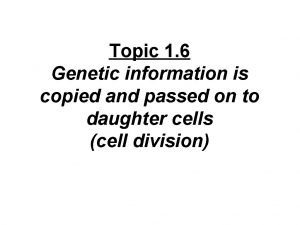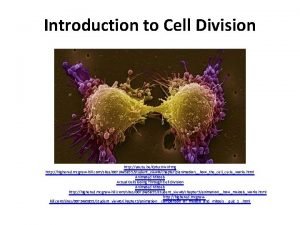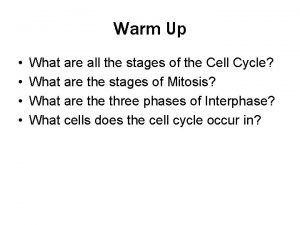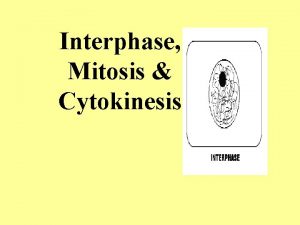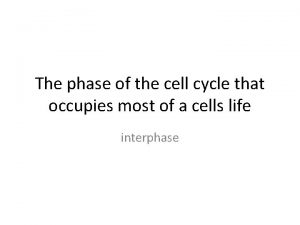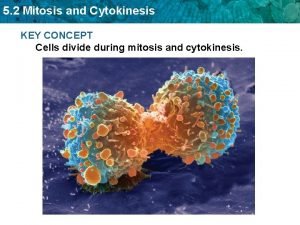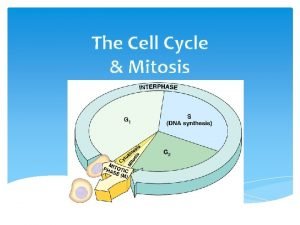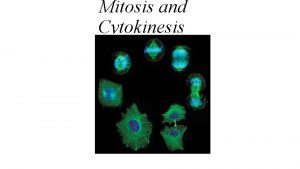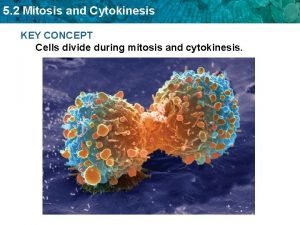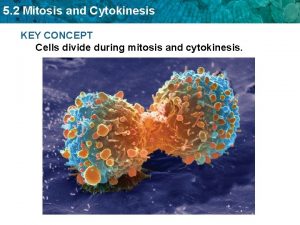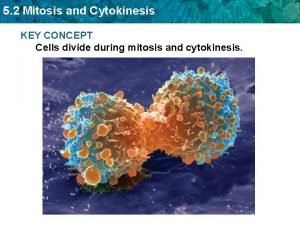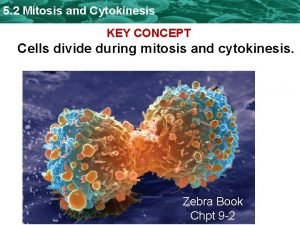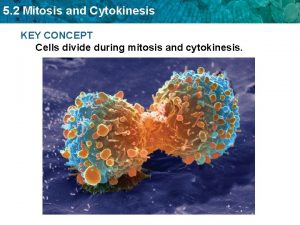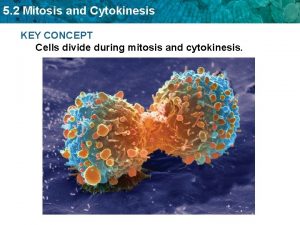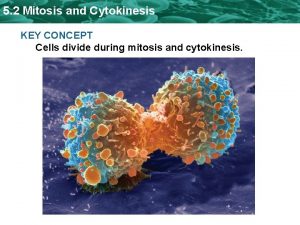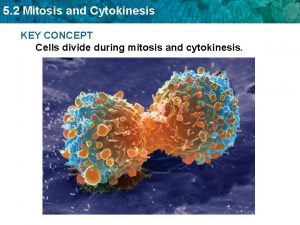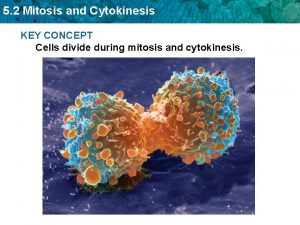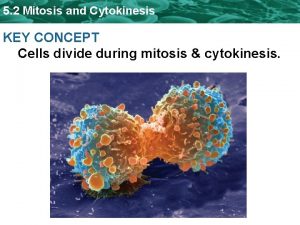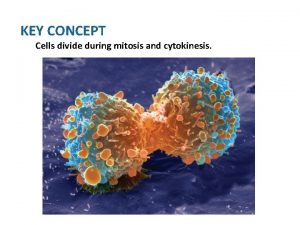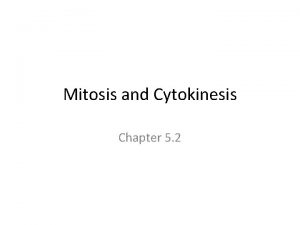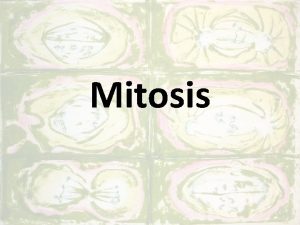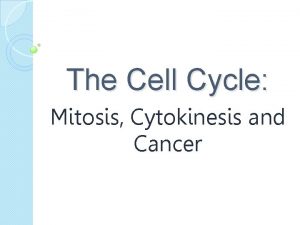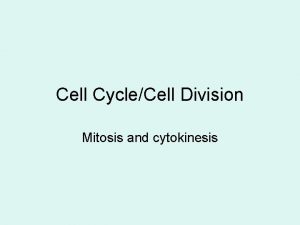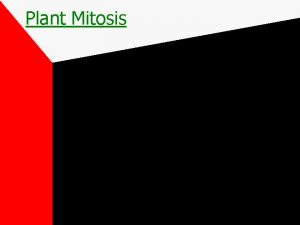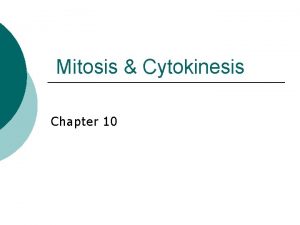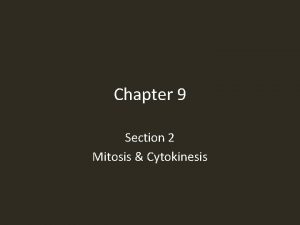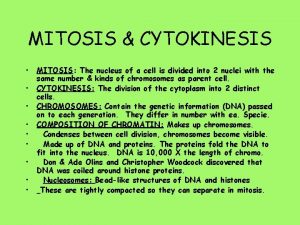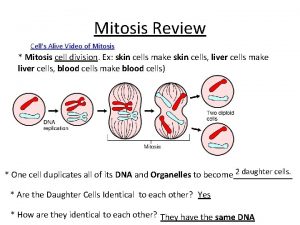Mitosis and Cytokinesis KEY CONCEPT Cells have distinct























- Slides: 23

Mitosis and Cytokinesis KEY CONCEPT Cells have distinct phases of growth, reproduction, and normal functions.

Mitosis and Cytokinesis The cell cycle has four main stages. • The cell cycle is a regular pattern of growth, DNA replication, and cell division.

Mitosis and Cytokinesis • The main stages of the cell cycle are gap 1, synthesis, gap 2, and mitosis. – Gap 1 (G 1): cell growth and normal functions – DNA synthesis (S): copies DNA – Gap 2 (G 2): additional growth – Mitosis (M): includes division of the cell nucleus (mitosis) and division of the cell cytoplasm (cytokinesis) • -

Mitosis and Cytokinesis Interphase -The purpose of interphase is for cell growth. By the end of interphase a cell has two full sets of DNA (chromosomes) and is large enough to begin the division process.

Mitosis and Cytokinesis • Interphase is divided into three phases. Each phase is characterized by specific processes involving different structures. • • During the S (synthesis) phase, chromosomes replicate and divide to form identical sister chromatids held together by a centromere. • During the G 2 (gap 2) phase, cells continue to grow and produce the proteins necessary for cell division.

Mitosis and Cytokinesis

Mitosis and Cytokinesis Mitosis • - • Each cell has to have its own cytoplasm and DNA. • The DNA is replicated in Interphase when two chromosome strands became four strands (two strands per chromatid). • In mitosis the four strands (two sister chromatids) have to break apart so that each new cell only has one double-stranded chromosome.

Mitosis and Cytokinesis Mitosis is divided into four phases. Each phase is characterized by specific processes involving different structures. 1. 2. 3. 4. -

Mitosis and Cytokinesis Prophase is characterized by four events: 1. 2. 3. Centrioles have separated and taken positions on the opposite poles of the cell. 4. Spindle fibers form and radiate toward the center of the cell.

Mitosis and Cytokinesis Chromosomes condense at the start of mitosis. • DNA wraps around proteins (histones) that condense it. DNA double helix DNA and histones Chromatin Supercoiled DNA

Mitosis and Cytokinesis • Mitosis divides the cell’s nucleus in four phases. – During prophase, chromosomes condense and spindle fibers form.

Mitosis and Cytokinesis Metaphase (the shortest phase of mitosis) is characterized by two events: 1. 2. -

Mitosis and Cytokinesis • Mitosis divides the cell’s nucleus in four phases. – During metaphase, chromosomes line up in the middle of the cell.

Mitosis and Cytokinesis Anaphase is characterized by three events: 1. 2. 3. Separated chromatids move to opposite poles of the cell.

Mitosis and Cytokinesis • Mitosis divides the cell’s nucleus in four phases. – During anaphase, sister chromatids separate to opposite sides of the cell.

Mitosis and Cytokinesis Telophase (the last phase of mitosis) consists of four events: 1. 2. A nuclear envelope forms around the chromosomes at each pole of the cell. 3. Spindle fibers break down and dissolve. 4. -

Mitosis and Cytokinesis • Mitosis divides the cell’s nucleus in four phases. – During telophase, the new nuclei form and chromosomes begin to uncoil.

Mitosis and Cytokinesis • Cytokinesis is the division of the cytoplasm into two individual cells. • • In animal cells the cell membrane forms a cleavage furrow that eventually pinches the cell into two nearly equal parts, each part containing its own nucleus and cytoplasmic organelles.

Mitosis and Cytokinesis Animal Cell Telophase/Cytokinesis

Mitosis and Cytokinesis • Cytokinesis differs in animal and plant cells. – In animal cells, the membrane pinches closed. – In plant cells, a _____forms.

Mitosis and Cytokinesis • In plant cells a structure known as a cell plate forms midway between the divided nuclei, which gradually develops into a separating membrane. • The cell wall forms in the cell plate.

Mitosis and Cytokinesis Plant Cell Telophase/Cytokinesis

Mitosis and Cytokinesis Cells divide at different rates. • The rate of cell division varies with the need for those types of cells. • Some cells are unlikely to divide (G 0).
 Chapter 9 section 2: mitosis and cytokinesis
Chapter 9 section 2: mitosis and cytokinesis Mitosis and cytokinesis images in order
Mitosis and cytokinesis images in order Equator in mitosis
Equator in mitosis Cell in interphase labeled
Cell in interphase labeled Cytokinesis usually but not always follows mitosis
Cytokinesis usually but not always follows mitosis Handwriting คือ
Handwriting คือ Prometaphase
Prometaphase Crossing-over occurs during
Crossing-over occurs during What are spindle fibers made of
What are spindle fibers made of Significant instrument of israel
Significant instrument of israel Onodi cells
Onodi cells Red blood cells and white blood cells difference
Red blood cells and white blood cells difference Venn diagram animal and plant cells
Venn diagram animal and plant cells Masses of cells form and steal nutrients from healthy cells
Masses of cells form and steal nutrients from healthy cells Cells undergoing mitosis
Cells undergoing mitosis Youtu.beq
Youtu.beq Bone cells mitosis
Bone cells mitosis What happens in cytokinesis
What happens in cytokinesis Interphase to cytokinesis
Interphase to cytokinesis Predict what would happen if cytokinesis was skipped
Predict what would happen if cytokinesis was skipped What occurs after cytokinesis is completed?
What occurs after cytokinesis is completed? Cytokinesis
Cytokinesis Mitosis
Mitosis Pmat mitosis
Pmat mitosis
